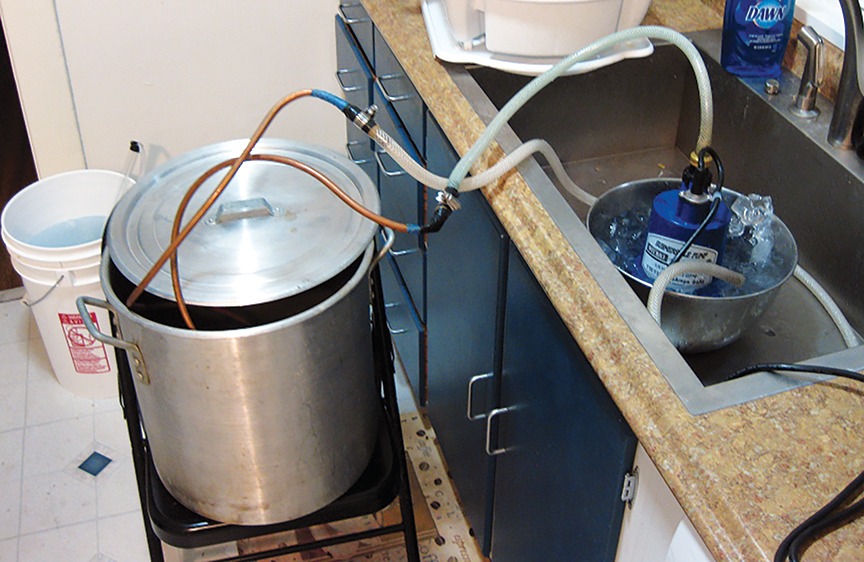Understanding Mash Chemistry
Mash chemistry is one of those final pieces of the brewing puzzle that many homebrewers, and even some pros, choose to ignore. Perhaps they think it is too complicated. Or maybe they are just lazy. Either way, it’s a shame because all-grain brewers brew their best beer with at least a basic understanding of how grains, minerals, and acids affect mash pH. It’s also fairly simple once the basics are understood — no chemistry degree required! Though, of course, it certainly wouldn’t hurt.
You might recall from high school chemistry that pH is a logarithmic scale that expresses the alkalinity or acidity of a substance. pH is considered neutral at 7. A solution under pH 7 is considered acidic, while over pH 7 is considered alkaline.

Distilled water clocks in at pH 7 right out of the distillation process, but as it picks up CO2 from the atmosphere, its pH will drop to around 6.5 because CO2 is acidic. Dissolved minerals can likewise lower or raise the pH of water. Dissolved minerals are the primary driver of water’s pH. The pH of most municipal water will hover between 6.5 and 8.5, determined mainly by dissolved minerals.
However, the pH of water is of minor importance to brewing. What’s important is the mash pH, which can change drastically depending on the grist bill.
When we add pale malt to our brewing water, it will lower the pH because pale malt is mildly acidic. Mashing pale malt with almost any potable water source will lower the mash into the pH 5–6 range. Most likely, it will drop the range between 5.4–5.8. And that’s great! Because this is within the enzymatic conversion range. Practically, that’s all you have to do: Mix your grain with hot water, and mashing will take care of itself. Voila!
But, if we want to make the best beer possible, the range of pH we are looking for is a bit narrower — for most light beer, we are looking for a pH range of about 5.2–5.4, and for most dark beer, we are looking for a range between 5.4–5.6.
As mentioned, pale malt is mildly acidic, so when mixed with water it lowers the pH. Darker malt, especially roasted malt, is even more acidic. Combining a 100% Pilsner malt grist with distilled water will give us a pH of about 5.75. If we mix a stout grist with lots of roasted malts in distilled water, our pH may drop below 5 because of the acidity of dark malts.
Sticking with these two examples, if we add a weak acid such as lactic acid to the Pilsner mash, we can lower the pH of that solution closer to 5.2–5.4. Likewise, if we add a weak base, such as sodium bicarbonate, to our stout mash, we can raise the pH to 5.4–5.6. How much acid or base we need to affect the pH depends on the makeup of the grist since malt will act as a buffer and resist the change. If the water is high in dissolved minerals, especially carbonate and bicarbonate, these will also serve as a buffer.
Buffers in the Water and Mash
Back to our foggy high school chemistry class, recall that buffers in a solution act to resist pH change. When adding an acid or a base to the mash, the pH first appears not to change. Envision the mash represented as an empty glass, and the water added to it represents the pH. The glass can only hold so much water. Drop by drop, you add water until it reaches a point where it overflows. You can think of the mash working the same way: You add acid or base milligram by milligram, and very little change happens until suddenly the buffers in the mash can’t resist anymore, and the pH changes drastically.
In the example of the stout or Pilsner grist, we used distilled water as a theoretical example. Real-world mashes use water with at least trace minerals since they improve enzymatic action and yeast health.
Distilled water has almost no buffering capacity, but dissolved solids in our water can act as buffers, specifically carbonate and bicarbonate. This means that when we add our Pilsner malt or our stout grist to our tap water, the pH will be affected by the buffering capacity of these dissolved solids, which will resist the pH change.
Consider the water that flows from your faucet: Tap water that has low mineral content has minimal buffering capacity, similar to, but not quite as extreme as, distilled water. In contrast, water high in minerals — especially carbonate and bicarbonates — will have more buffering capacity. Carbonate and bicarbonate are the big playmakers here and are the dissolved solids that mainly affect the water’s alkalinity. The alkalinity is responsible for most of the buffering capacity in our water, which directly affects the pH of the mash. Therefore, highly alkaline water has a very high buffering capacity and resists
pH change.
In contrast, low alkalinity water has much less buffering capacity, and the pH can be easily changed. What makes things interesting is that the alkalinity of your water will determine what color beer it is best suited to brew, meaning where the pH will fall into range without (or with minimal) mineral or acid additions. This information can be found in your water report.
Water Report and Alkalinity
There’s lots of information to unpack in a typical water report, but only a few items are helpful for brewing. The information also isn’t necessarily standardized in the way it is presented and might read differently depending on your municipality. But every report should list an approximation of the following:
Calcium (Ca2+)
Magnesium (Mg2+)
Sulfate (SO42-)
Sodium (Na+)
Chloride (Cl–)
Bicarbonate (HCO3-)
Alkalinity, or Alkalinity as HCO3-
Hardness, or Hardness as HCO3-

Calcium, magnesium, sulfate, sodium, and chloride all have some effect on the final beer’s flavor and, to a lesser degree, the mash pH (we will get to these in a moment). But it’s the bicarbonate (HCO3-) that has the most impact on the mash alkalinity and, therefore, the mash’s buffering power. So much so that if your water report doesn’t have a value for “bicarbonate/HCO3-,” you can substitute the value given as “alkalinity” or “alkalinity as CaCO3” since the majority of alkalinity will usually be bicarbonate.
The alkalinity of your water will determine what color of beer your water is best suited to brew. Water between 0–50 ppm (mg/L) levels is ideal for extremely pale beer. For pale to amber beers, 50–150 ppm (mg/L), and for dark beers, 150–300 ppm (mg/L). Higher alkalinity will help to neutralize darker and more acidic malts and target the mash into the proper enzymatic pH range.
“Hardness” or “hardness as HCO3-” refers to water’s calcium and magnesium concentration. While “alkalinity as HCO3-” and “hardness as HCO3-” are not the same, they are somewhat linked. For example, boiling water high in “hardness” can cause some of the bicarbonate and/or carbonate to bind with the calcium and/or magnesium, precipitating some of it out as calcium carbonate and lowering the water’s hardness and alkalinity. This is known as temporary hardness. It was once a standard method to soften brewing water while reducing its alkalinity (the layer of calcium carbonate will be seen on the bottom of the kettle after the boil and time to settle). However, homebrewers will probably find it easier and less energy-intensive to dilute their water with distilled or reverse osmosis (RO) water instead of boiling to reduce hardness and alkalinity. It’s also more accurate.
For instance, if the alkalinity of your water is 100 and you split it 50/50 with distilled water, the alkalinity will be at 50 ppm — within the range of pale beer so that only a tiny amount of acid will be needed (if any) to hit your pH. You can use whatever ratio of distilled or RO water you like to get your alkalinity to your desired ppm, but remember, if you use all or close to all distilled or RO water, you need to add some minerals back in — most likely calcium, at the very least, for yeast health.
Checking the Mash pH
As stated, as long as it is between the “normal range” of about 6.5–8.5 pH, the pH of your water is of little concern. What matters is the pH of the mash.
The best way to check the pH of the mash is with a pH meter that has been properly calibrated between 4.01 pH and 7.01 pH using calibration solutions. Every pH meter brand is different, and the calibration and usage instructions must be followed. The pH meter should be calibrated before every brewing session.
When checking the mash or wort pH, it’s best to cool the sample to room temperature for an accurate reading. A correction must be made if the sample is too hot or too cold. A pH reading at mash temperature will be off by about +0.2 points. A sample at refrigeration temperature will be off by about -0.01.
Disposable pH strips are better than nothing, but their accuracy may be suspect, and the reading challenging to determine. Be sure to use pH papers within the 4.01 pH and 7.01 pH range.
Lowering the pH in the Mash
Remember: The alkalinity of the water acts as a buffer to the mash, and the mash acts as a buffer to anything we add to adjust its pH. Also, recall that for a pale beer, the ideal alkalinity of our water is under 50 ppm.
Water alkalinity under 50 ppm doesn’t mean that adjustments won’t be needed on pale beers to bring the pH between 5.2–5.4. It just means that smaller adjustments will be required. Likewise, just because the alkalinity of water is over 50 ppm doesn’t mean you can’t brew pale beers. While dilution with distilled or RO is preferred, it isn’t always possible. Many brewers with high alkalinity use acids, acidulated malts, etc., to lower the pH of their mash to the desired range. The higher the alkalinity of the water, the more acid or acidulated malt, etc., will be needed. The problem is that the more acid added, the more potential it has to change the beer’s flavor.
Because each mash and water source is different, it is difficult to calculate how much acid will be needed for any given mash to make adjustments. Based on input, the brewing water software can estimate how much acid is required to adjust the mash to your desired pH. If you don’t have access to software, then the best way to adjust the pH in your mash is to add the acid a drop or two at a time, stir well, and check to see if it has made a difference. Obviously, the smaller the mash, the smaller the amount added. Likewise, the higher the alkalinity of the water, the more acid is required. Once the capacity of the buffering power is reached, pH change happens rapidly.
Lactic acid
Is a common food-grade acid used to adjust the pH in the mash since the flavors it provides are pleasant when under a certain threshold. But, if too much is used, it can create a sour “twang” that can detract from the beer.
Phosphoric acid
Is another common food-grade acid used to adjust the mash pH. In beer, it is almost flavorless. Malt naturally releases phosphates during the mash, which resembles phosphoric acid’s flavor.
Acidulated (or acid) malt
The Reinheitsgebot (German Law of Beer Purity) doesn’t allow any acid additions to be introduced when brewing, so the Germans found a clever way around this: Acidify the malt with a mild lactic acid fermentation.
Every 1% acidulated malt (by weight) of the total grain bill reduces the mash pH by 0.1 points. If your water is high in alkalinity, you can use up to 10% acid malt in the total grain bill without off-flavors.
Sauergut
German brewers have also skirted the Reinheitsgebot by souring a small portion of wort, called sauergut, and adding it to the mash to lower the pH. Sauergut can be made by adding a pure pitch of Lactobacillus or a small amount of barley malt (already naturally crawling with Lactobacillus) to the sample portion. The wort will then acidify and sour, as quick as in just few hours when kept about 108–112 °F (42–44 °C). A common practice is making the sauergut 12–24 hours before brewing, letting the sauergut sour to around pH 3.5 or under, and then portioning it off into the main mash to adjust the pH as necessary. Many brewers find adding sauergut to their mash is an easy way to adjust the pH and put a unique flavor print on their beer.
Minerals to lower pH
Calcium chloride (CaCl2) and Calcium sulfate, aka gypsum (CaSO4), can also lower the mash pH, but since they are flavoring salts, their flavor needs to be taken into consideration first. The amount of CaCl2 or CaSO4 needed to make pH changes may put them out of the acceptable flavor range unless using water with extremely low alkalinity. Their usage will be discussed later.
Raising the pH in the Mash
The pH of the mash should only need to be raised when brewing amber or dark beers. For stouts or porters, high alkalinity is necessary to land in the 5.4-5.6 zone. If the water source is already high in alkalinity, only minor adjustments will be needed (if any). Sodium bicarbonate (NaHCO3) and calcium carbonate (CaCO3) are the most common minerals to raise the alkalinity.
Calcium carbonate (CaCO3)
Is largely flavorless and does a great job raising alkalinity in nature due to time and dissolved CO2 from the atmosphere. In the brewery, calcium carbonate will not dissolve well in tap water. More of it will dissolve in the mash due to the lower pH, but much of it will precipitate out. It will raise your calcium and may increase your alkalinity, but it is difficult to say how much. Because it is unpredictable, it’s not the best method of raising alkalinity. Since calcium is soluble, 1 gram of calcium carbonate per gallon (4 L) should raise calcium by about 50–55 ppm (mg/L). Since the carbonate is less soluble, 1 gram per gallon (4 L) may increase your CaCO3 by as much as 160 ppm (mg/L), or it could be much less, depending on how much gets dissolved.
Sodium bicarbonate (NaHCO3)
Or baking soda, will dissolve well in both brewing water and the mash and does a consistent job of raising the alkalinity and the pH of the mash. The problem is that it must be added judiciously since it will increase the sodium and affect the beer’s overall flavor. The flavor threshold of sodium varies from person to person, but a good rule is to keep the sodium (Na+) under 100 ppm (mg/L) lest the beer taste “salty.” One gram per gallon (4 L) of sodium bicarbonate in distilled water will raise the carbonate to about 190 ppm (mg/L) and the sodium to about 75 ppm (mg/L). For dosage, a good rule is not to go over 1.25 grams per gallon (4 L) to avoid issues with excessive sodium. If more alkalinity is desired, but the sodium is hitting the threshold, the brewer should try blending in some calcium carbonate.
Minerals for Beer Flavor
The other minerals on the water report don’t do as much to affect the mash pH, but they do play a nuanced, though vital, role in beer flavor. As an analogy, let’s use table salt: When cooking, the right amount of salt makes the dish “pop.” Not enough, and the flavor is bland and boring. Too much, and the meal is inedible. Using minerals in brewing can have similar consequences.
Calcium sulfate (gypsum)
Gypsum profoundly affects beer’s “dryness” and can accentuate hop bitterness and, to some extent, hop aroma. It is historically the most popular flavoring salt used in brewing.
One gram of gypsum per gallon (4 L) of water will add about 60–62 ppm (mg/L) of calcium and 145–147 ppm (mg/L) of sulfate. It’s best to stay below 350 ppm (mg/L) of sulfate. While many brewers add gypsum indiscriminately to their mash (and even wort), remember that it is not a magical flavoring salt and can be overdone, creating harsh and unpleasant flavors.
Calcium chloride (CaCI2)
Calcium chloride emphasizes malt character while softening hop flavor or bitterness. It is nearly flavorless but will “sweeten” and “round” malt flavors when used at low levels. Calcium chloride is a valuable tool to raise water’s calcium to acceptable levels without raising sulfate.
One gram of calcium chloride per gallon (4 L) of water will raise the calcium to about 70–72 ppm (mg/L), while raising the chloride level to about 125–127 ppm (mg/L). It is best to keep the chloride level under 250 ppm (mgLl) for most beers, as too much chloride can make a beer taste salty or chemically.
Epsom salt (MgSO4)
Epsom salt is used to raise magnesium (Mg) or to raise sulfate (SO4) without raising calcium. It is commonly employed to recreate the classic Burton-on-Trent water profile for British-style ales (along with gypsum). However, Epsom salt must be used sparingly because magnesium can have a laxative effect — which could create quite a surprise at an inopportune time for the unsuspecting drinker.
One gram of Epsom salt per gallon (4 L) of water will raise the sulfate to about 101–103 ppm (mg/L) and the magnesium to about 24–26 ppm (mg/L). It’s best to keep the magnesium under about 35 ppm (mg/L).
Salt (sodium chloride, NaCI)
Non-iodized table salt affects flavor and can make the beer taste more “full” and “round.” If your beer tastes “thin,” adding a little salt may fill out the flavors and make for a more tasty beer. Be sure to use only non-iodized salt since iodine can affect yeast health.
Salt will raise the sodium levels as well as the chloride levels in brewing. One gram of salt per gallon (4 L) of water will increase the sodium (Na+) by about 102-104 ppm (mg/L) and the chloride (CI) by about 158–160 ppm (mg/L). While people’s flavor threshold to salt will vary, keeping sodium under 100 ppm (mg/L) is best. Avoid salt when using sodium bicarbonate since it can quickly raise sodium to unacceptable levels.
Sodium bicarbonate and calcium bicarbonate
Neither of these salts should be used as flavoring salts. However, they can affect flavor when combined with other salts: Calcium bicarbonate raises sodium, and both salts raise calcium. Watch your sodium and calcium levels when using these salts in conjunction with others.
Sulfate-to-chloride ratio
The sulfate-to-chloride ratio should be considered for any beer style, especially hop-forward beers. For example, hazy pale ales typically use a 1:2 sulfate-to-chloride ratio to emphasize the “softness” of these beers. On the other hand, a West Coast IPA may use a 2:1 sulfate-to-chloride ratio to accentuate dryness and hop bitterness.
You can use whatever sulfate-to-chloride ratio you like (1:3, 1:1, 4:1, 0:1, 1:0, etc.); it’s up to the brewer to experiment with these ratios to see what works best for their beers and their tastes.
Calcium Levels in the Mash
As alluded to, calcium is an essential mineral in beer, but not necessarily for flavor. Calcium in the mash positively affects the enzymes and improves enzymatic function while acting as a yeast nutrient.
Calcium also reacts to oxalic acid, a troublesome organic acid released during mashing. Calcium binds with oxalic acid to form calcium oxalate, aka beer stone, which will precipitate out of the mash. It’s important to handle it in the mash so it doesn’t form in fermenters or packaging. Beer stone forms a brownish deposit that can harbor bacteria, create nucleation points where CO2 collects, and cause excessive foaming and gushing. It is tough to remove without harsh acids.
To avoid problems with beer stone and provide yeast health and speedy mash conversion, be sure every mash has at least 50 ppm (mg/L) of calcium (calcium sulfate, calcium chloride, or calcium carbonate).
Water Chemistry Software
If you have your local water report, it’s easy to input those numbers into water and mash chemistry software to see how your water alkalinity affects the pH of your beer recipe. It also makes it easy to decide on RO or distilled water dilution ratios or mineral additions. Some can estimate how much acid or minerals are needed to bring your pH into the desired range. Some of the software is free online, while others are spreadsheets that can be downloaded for a small fee. Many recipe software programs and apps also include water chemistry software in their package.
This is an edited excerpt from Keith T. Yager’s Unlocking Homebrew: The Four Keys to Tasty Beer (self-published, 2024).







